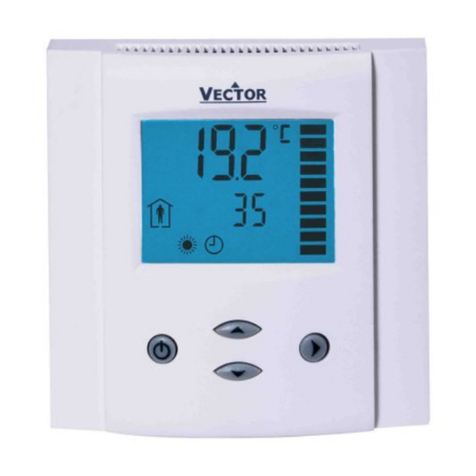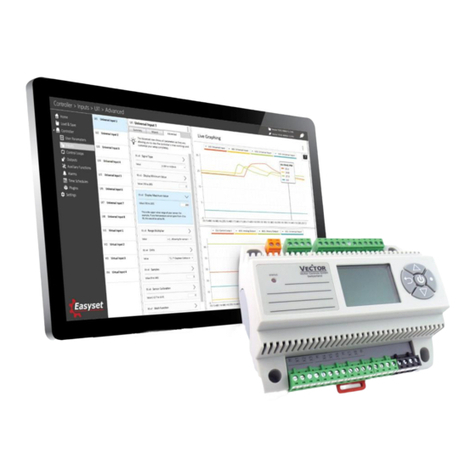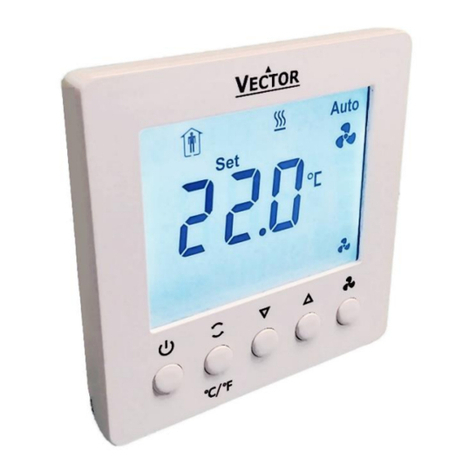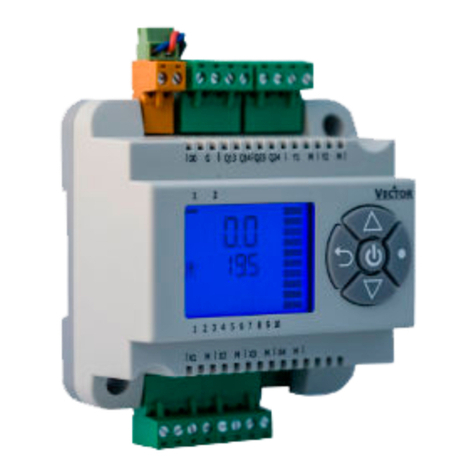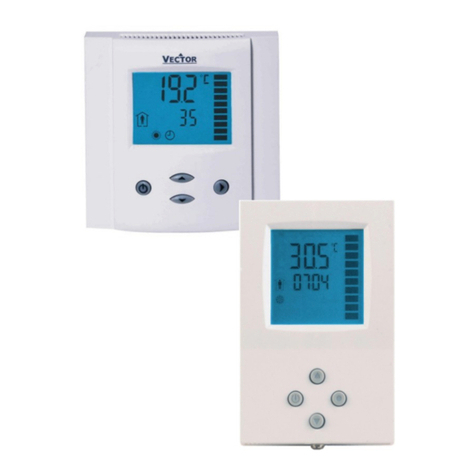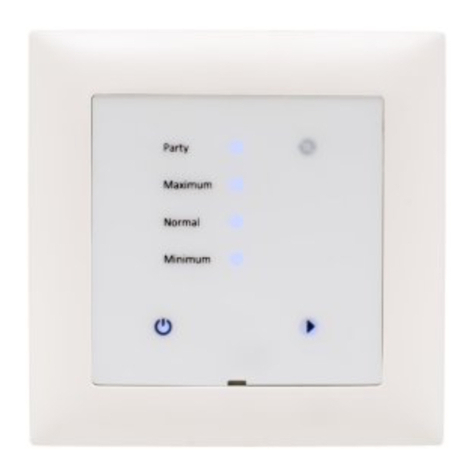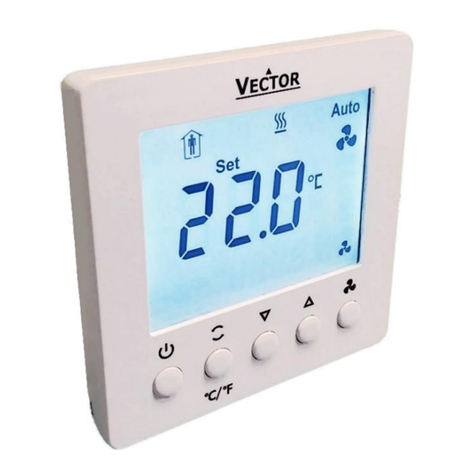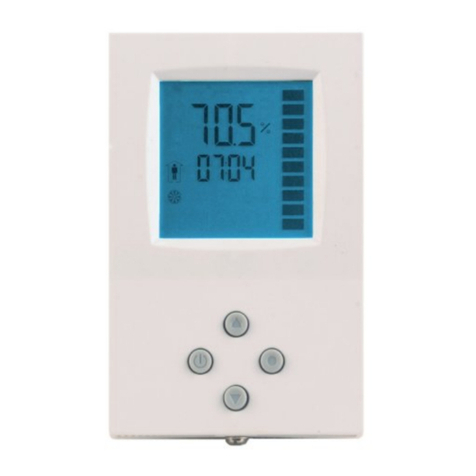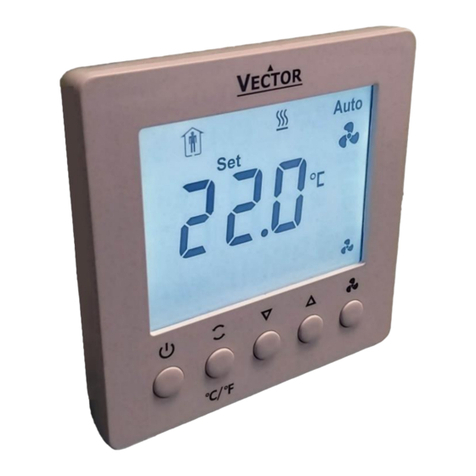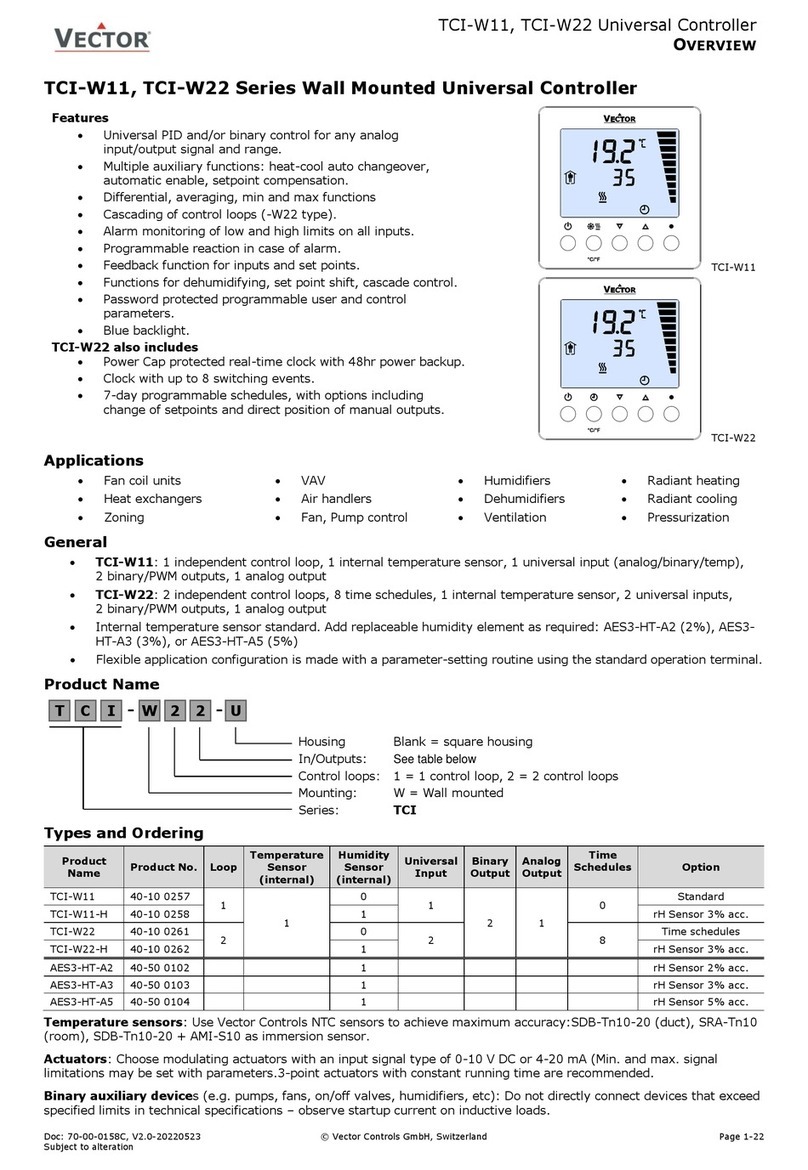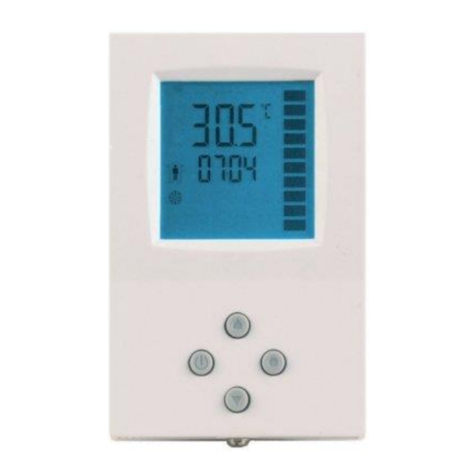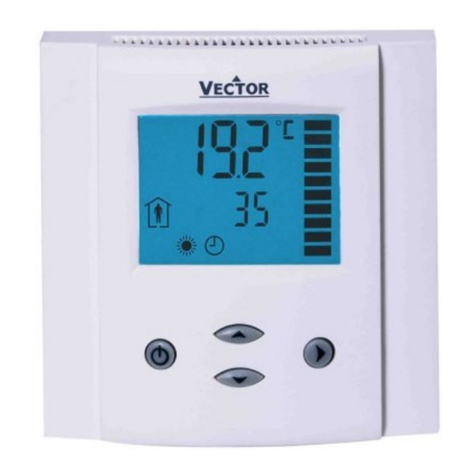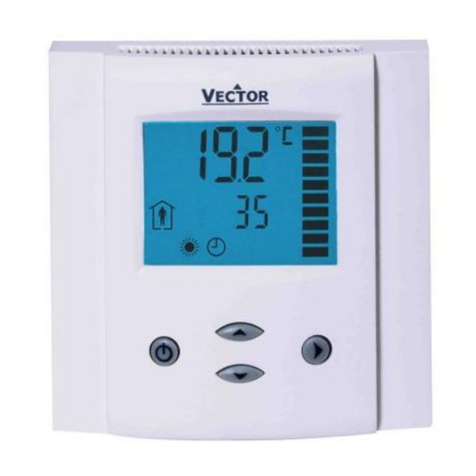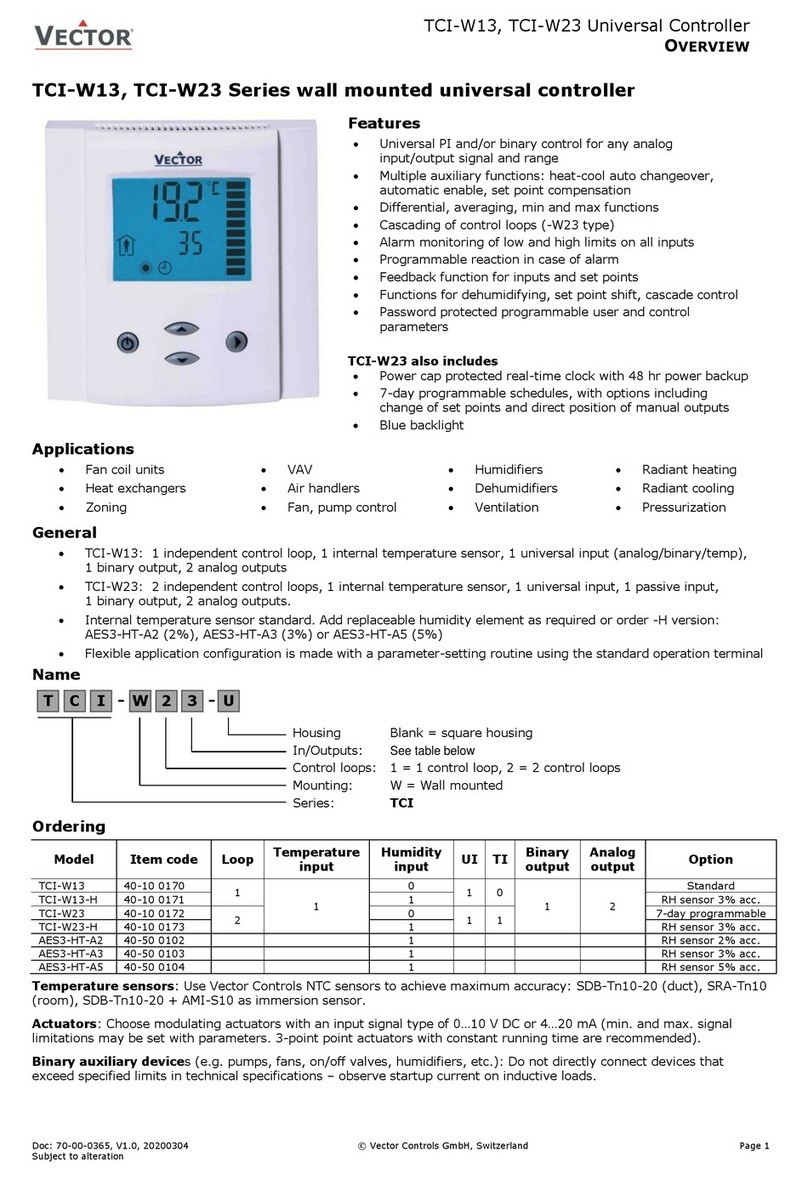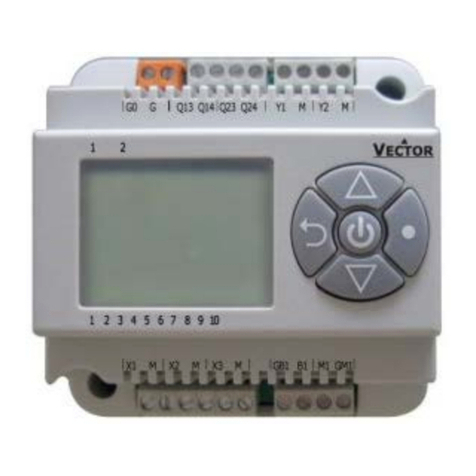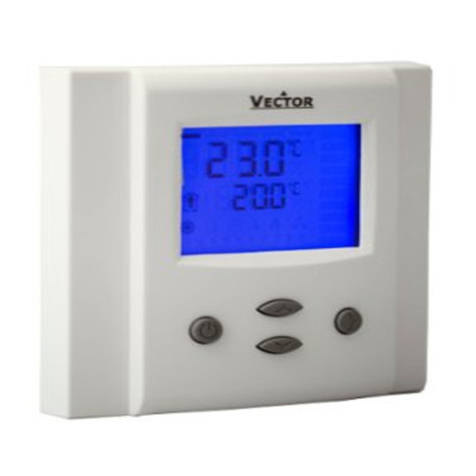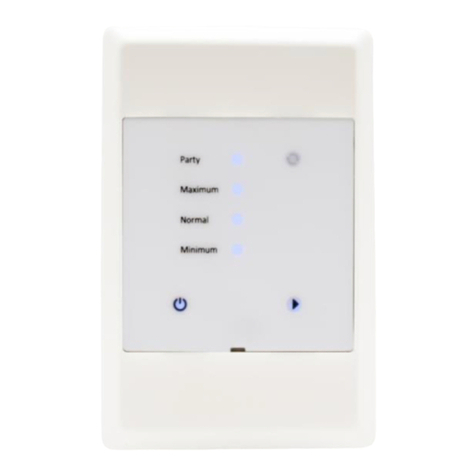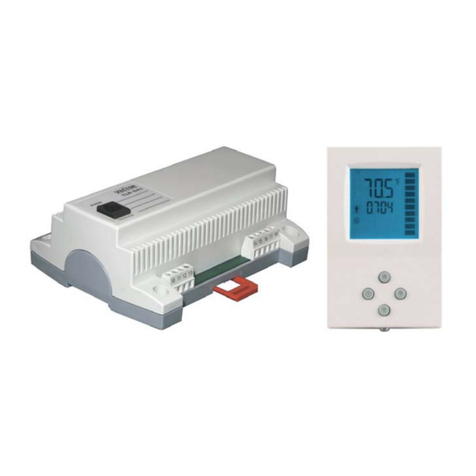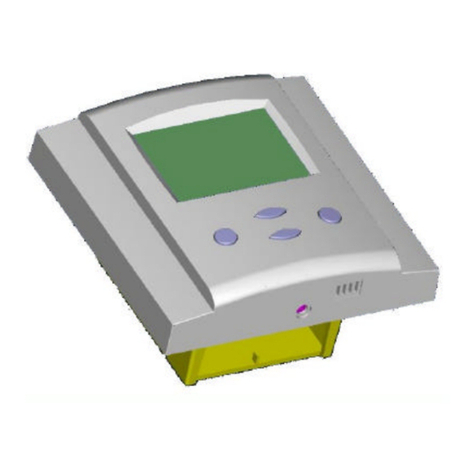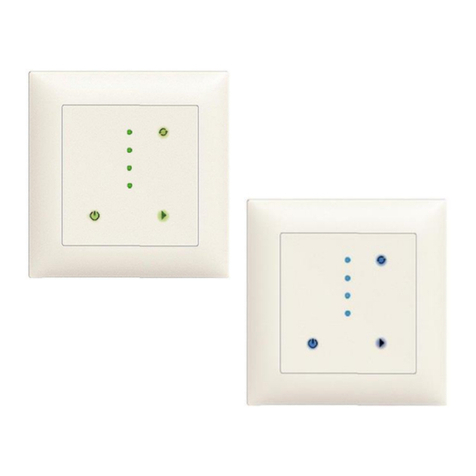
Temperature PID controller TCY-MT-U
Temperature PID controller TCY- MT-U
Temperature PID controller TCY- MT-U
Doc: 70-00-0177-20, V1.2 20160119 © Vector Controls GmbH, Switzerland Subject to alterations
Configuration parameters for firmware version 1.2
The TCY-MT-U is preset to work for most applications. For special requirementsit can be fine tuned to work
ideal with a simple parameter setup routine. The parameters can be changed on the unit without the need of
additional equipment.
Identifying the firmware version
The parameters andfunctionality of controller depend on its firmware version and revision. It is therefore
important to use a matching product version and parameter set. The Firmware version and revision version
can be found when pressing simultaneously the andkeys during several seconds. On the upper 7
segment display, the firmware version can be found, on the lower 7 segment display the current revision
index (or “sub-version”).
Setting of user parameters
The TCY-MT-U can be adapted tofit perfectly into your application. The control operation is defined by
parameters. The parameters are set during operation by using the control buttons.
The parametersmay only be accessed by entering a code. There are two levels of parameters: User
operation parametersfor access control settings, and Expert parameters for control functions and unit setup.
The codes for user levels and expert levels are different. Only control experts should be given the control
parameter code.
The parameters can be changed as follows:
1. PressUP and DOWN button simultaneously for three seconds. The display shows the software
version in the large digitsand the product codein the small digits.
2. Pressing the OPTION button will indicate CODE onthe small digits and 000 on the large digits.
3. The code for accessing the user parameters is 009
4. Select this using UP or DOWN buttons.
5. Press OPTION button after selecting the correctcode.
6. Once logged in, the parameter is displayed immediately.
7. Select the parameters with the UP/DOWN buttons. Change a parameter by pressing the OPTION
button. Three triangleswill show up on the lower right and indicate thatthe parameter may be
modified now. Use UP or DOWN buttonsto adjust the value.
8. After you are done, press OPTION or POWER in order to return to the parameter selection level.
Press the POWER button again so as to leave the menu. The unit will return to normal operationif no button
is pressed for more than 5minutes.
User parameters (Password 09)
Enable access to operation modes
Enable access to set points
Enable manual change of Heating/Cooling Mode.
No influence on TCY-MT2-U-W01 (cooling only) or
TCY-MT2-U-W02 (heating only)
TCY-MT2-W01: OFF
TCY-MT2-W02: OFF
TCY-MT2: ON
TCY-MT4: ON
State after power failure:
0 = off, 1 = on, 2 = state before power failure
Enable Economy (unoccupied) Mode.
Shift the set point to a lower temperature in winter or
higher temperature in summer in order to save energy.
May be activated through the POWER button, or with
the external input (typically for key card switches in hotel
rooms or motion detectors for meeting rooms.)
ON = Fahrenheit, OFF = Celsius
Calibrate internal temperature sensor
–10° to +10° in 0.1° steps. (Sensor is factory calibrated;
use this feature for field adjustment only as required.)
Enable Frost Protection.
Activates the output independent of operation mode
when the control temperature drops below 5°C or 41°F.
The controller returns to normal operation when the
temperature increases above 10°C or 50°F.
TCY-MT2-W01: OFF
TCY-MT2-W02: ON
TCY-MT2: ON
TCY-MT4: ON
Control parameters (Access code: 241)
Warning! Only expertsshould change these settings! See user parameters for login procedure.
Minimum set point limit in Heating mode
Maximum set point limit in Heating mode
Minimum set point limit in Cooling mode
Maximum set point limit in Cooling mode
Economy (unoccupied) Mode temperature shift:
The comfort (occupied) set point is shifted by the value set
with parameter. If heating is active the comfort set point will
be decreased, if cooling is active, the set point will be
increased. (Enable with UP06.)
Dead Zone Span (TCY-MT4-U only):
The Dead Zone Span lies between the heating and the
cooling set point. The outputis off while the temperature is
within the dead zone span. A negative dead zoneis not
possible.
Heat/Cool Changeover Delay (TCY-MT4-U only):
A demand to switch between heating and cooling must
persist for thelength of time set with this parameter before
the controller switches. Prevents activation of a sequence
during a short-term change in temperature in order to
protect equipment (with control overshoot for example)
KIH, Integral gain heating, in 0.1 steps, (TI is fixed to 4s)
0 disables ID part
low value = slow reaction
high value = fast reaction
KIC, Integral gain cooling, in 0.1 steps, 0 disables I part
Configuration of operation mode
0 = TCY-MT2-U-W01 = Cooling mode YC1
1 = TCY-MT2-U-W02 = Heating mode: YH1
2 = TCY-MT2-U = Heating and Cooling (2 pipe system)
3 = TCY-MT4-U = Heating and Cooling (4 pipe system)
TCY-MT2: 0 - 2
TCY-MT4: 0 –3
TCY-MT2-W01: 0
TCY-MT2-W02: 1
TCY-MT2: 2
TCY-MT4: 3
Proportional control (P-band)
The proportional control function calculatesthe output based on the difference between set point and
measured value. The proportional band (P-band) defines the difference between set point and measured
value which will result in a 100% output. For example, with a heating or reverse 0-10v control sequence, and
a 2.0°C (4.0°F) P-bandvalue, at 10v the controller will be 2.0°C (4.0°F) below set point. This is the working
range of the proportional control sequence.
Setting the proportional band to 0 disablesproportional control.
Integral and differential control
Proportional control is avery stable control mode. The flaw of proportional control alone, however, is that the
set point is normally not reached. As the measured value gets closer to the set point, the output reduces
until it reaches a point, a fraction above or below the set point, where the output equals the load. To reach
the set point and achieve a higher level in comfort the Integral/Differential function should be activated.
Integral Gain (KI) dynamically increases the output by the selected KI valueuntil the set point is reached.
The challenge, however, is to prevent hunting, where the output increases too fast, the temperature
overshoots the set point, the output goes to 0, thetemperature undershoots the set point, and the cycle
repeats itself. Hunting may result if the integral gain is too high. Each system is different. It is recommended
to start with a KI value of 0.5 for water based systems and 1.0 for air based systems. Reduce thisvalue if
the measured value overshoots the set point by more than 1°C (2°F). Increase the value if the output takes
too long to reach the set point. Air based systems react faster than water based systems.
Setting the integral gain to 0 disables integral and differential control.
Output configuration
Manual Override Mode:
Allows manual control of the analog outputsfor using the
controller as positioned, or during commissioning.
Min output for AO1 (TCY-MT4-U = heating output)
Max output for AO1 (TCY-MT4-U = heating output)
Min output for AO2 (TCY-MT4-U = cooling output)
Max output for AO2 (TCY-MT4-U = cooling output)
Maximum Output in Economy (unoccupied)Mode
Reduces the load on the system when is the space is
unoccupied.
Configuration of remote control input (X1)
0 = Control input if temperature sensor connected
1 = Occupation sensor –Comfort / Standby
2 = Remote enable –Comfort / OFF
3 = Keycard function: fixed set point
Activation delay (Minutes) = the time the binaryinput needs
to be open before standby/off mode is activated.
Fixed set point for key card function in heating mode
Fixed set point for key card function in cooling mode
For TCY-MT2-U only: Enable Auto changeover
For TCY-MT2-U only: Auto-changeover limit heating
For TCY-MT2-U only: Auto changeover limit cooling
Configuring the function of the external input X1
The external input X1 may be configured for several functions:
The control input is provided by the external input. The
internal input will not be used.
Switching Economy
and Comfort modes
Economy (unoccupied) and Comfort (occupied) modes
are controlled through an external contact by connecting
X1 through a dry contactto signal common. This function
may be used together with key card switches for hotels or
motion detectors for offices.
Switching Energy
Hold OFF and
Comfort modes
Opening the external temperature input will force the unit
into the OFF operation mode. The operation mode cannot
be overridden by using theterminal. Connectingthe
binary input to GND returns control of the operation mode
to the terminal. Thisfunction may be used as window
contact to prevent loss of energy.
As with CP18 = 1, the key card function switches
economy (unoccupied) and comfort (occupied) modes.
Instead of usingthe set point shift, the set points in
unoccupied mode are defined by parameter CP20 and
CP21.
This may be used for a dewpoint sensor input. Output will
switch off if contact opens.
Configuring auto changeover input X2 (TCY-MT2-U only):
The auto changeover function automatically changes heating and coolingmode based on supply
media temperature or outdoor temperature. The difference between the two is in the values of the
changeover limits CP23 and CP24. See table below for recommended settings.
Heating and cooling may be as well changed by an open contact switched to signal ground. Note: all
signal ground levelsof involved controllersmust be the same in case more than one controller is
switched.
Recommended settings for CP23 and CP24:
Dry contact: Heating if contact closed
Dry contact: Cooling if contact closed
